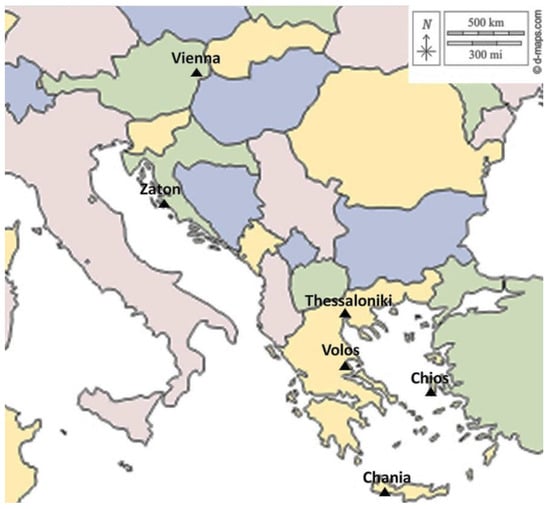1. Introduction
Environmental stress resistance and the ability to adapt to novel or changing environments are essential factors that influence the ecological patterns (e.g., population density, migration, habitat use) and biogeographic distribution of invasive species [
1]. Invasive species can cause a range of negative impacts, including disruptions to ecosystems, loss of biodiversity, and economic effects in the invaded areas [
2]. Climate change is expected not only to alter the insect distribution but also to increase the threat of invasive species as tropical and subtropical insects expand their geographic range into temperate areas [
3,
4]. Understanding the relationship between invasion and range expansion can provide insights into the mechanisms facilitating geographic spread [
5].
Biological invasions, despite their detrimental ecological consequences, provide a valuable framework for studying evolutionary processes in real time. When non-native species establish in novel environments, they are exposed to selective pressures distinct from those in their native ranges. These pressures encompass a range of abiotic factors, such as climate and soil composition, as well as biotic interactions like competition and/or predation. To thrive, persist, and expand in these new habitats, invaders must rapidly adapt, which often results in accelerated evolutionary changes. These adaptations, driven by natural selection, phenotypic plasticity, and underlying genetic variation, enhance the species’ fitness in new conditions. The study of biological invasions, therefore, offers critical insights into evolutionary mechanisms, revealing how species respond and evolve under new environmental challenges beyond their native range [
6].
The Mediterranean fruit fly (medfly),
Ceratitis capitata (Wiedemann) (Diptera: Tephritidae), is a highly destructive pest with significant economic consequences for global fresh fruit production [
7]. Having originated in Africa,
C. capitata has rapidly expanded its distribution to temperate and tropical regions across the globe within the last two centuries [
8]. In recent years, its presence has also been reported in cooler, more temperate zones [
9,
10]. The species’ successful invasion and establishment in these diverse environments can be attributed to local adaptation or phenotypic plasticity [
3]. Several key biological and physiological characteristics of
C. capitata contribute to its invasion success, including its high polyphagy, short life cycle, strong dispersal ability, and capacity for rapid adaptation to a wide range of climatic conditions [
11,
12,
13,
14]. Moreover, climate change is anticipated to further influence the global distribution and performance of
C. capitata by creating conditions that enhance its survival and reproduction in areas previously unsuitable for its establishment [
10,
15].
Despite the extensive research on the biology and ecology of
C. capitata, the extent to which physiological and life history traits contribute to its successful introduction into novel environments remains unclear [
1]. Geographic diversity of genotypes and phenotypes in medfly populations can indeed emerge as a result of adaptation to novel habitats [
16]. Responding to abiotic factors, like temperature, humidity, and photoperiod, as well as biotic factors such as host availability, can lead to adaptation that causes shifts in the genetic architecture of populations, resulting in alterations to crucial life history and behavioral traits [
17]. Medfly biotypes originating from various regions worldwide, each with distinct invasion histories, have evolved different life history strategies to cope with local environmental conditions [
6,
18].
To comprehend the life history strategies that
C. capitata may have developed to cope with local conditions at the front of its geographic range, Papadogiorgou et al. (2024) [
19] examined the performance of immatures of six medfly populations that originated from environmentally diverse habitats (from Southern to Central Europe) to two key overwintering hosts (apples and bitter oranges) under a range of constant temperature conditions (15, 20, and 25 °C). Earlier studies demonstrated that medfly overwinters in cooler temperate areas as larvae in overwintering hosts (e.g., apples) that remain in orchards at relatively good conditions until spring [
20,
21,
22]. The results revealed varying responses of medfly populations to different overwintering hosts and temperatures, highlighting the differential overwintering capacity of larvae of the different populations. Prevailing environmental conditions can stimulate developmental plasticity in individuals [
23]. These plastic responses to environmental changes, including thermal stress, and the interaction between nutrition and thermal stress are considered important components of the
C. capitata invasion success [
14,
24,
25]. The rate of larval development is notably influenced by temperature and host fruit [
26]. The effects of temperature encompass a wide range of physiological processes [
27]. While warm temperatures tend to accelerate developmental rates, leading to a new generation consisting of poorly adapted individuals to winter conditions, lower temperatures may result in extreme phenotypes that possess adaptations allowing them to effectively cope with harmful winter conditions [
21]. Similarly, host fruit cultivar in combination with ripening stage can influence the development of
C. capitata immature stages and subsequently its demographic traits [
28]. Larval diet with increased protein content tends to accelerate developmental processes, leading to shorter developmental time [
23,
29]. Hence the choice of nutritional resources (host selection) by adult females can influence medfly’s life history characteristics, such as the emergence of adults, pre-oviposition period, egg production, mating success, and adult longevity [
30].
The demographic traits of the medfly have been extensively studied over the past few decades, with most research focusing on laboratory-adapted populations [
26,
31,
32,
33,
34]. These populations, having undergone significant changes in life history traits through laboratory adaptation, may not accurately represent the natural life history strategies of geographically isolated medfly populations. In contrast, Diamantidis et al. (2008) [
35] investigated the demographic responses of six geographically distinct medfly populations (from Greece, Kenya, Portugal, Brazil, Hawaii, and Guatemala) under controlled conditions. The study revealed that medflies from Kenya, Hawaii, and Guatemala exhibited shorter lifespans compared to those from Greece, Portugal, and Brazil. This finding suggests that regions with seasonal or temperate climates select for longer adult lifespans, likely as an adaptation to periods of limited host fruit availability.
Medfly populations established in regions with varying ecological characteristics demonstrated differences in several biological traits during both early developmental stages (larval/pupal) and adult life, reflecting local adaptations and the distinct selective pressures encountered in different environments. This is consistent with Malacrida et al. (1998) [
36], who reported modest genetic divergence among medfly populations originating from the Mediterranean, compared to ancestral populations from Southeastern Africa. In tropical regions, where host fruits are more likely to be available throughout the year, adaptations may not favor longer adult lifespans. Thus, evolutionary processes that shape genetic traits may have had a limited impact on genes influencing life history traits, such as longevity [
35]. However, little is known about the potential influence of immature developmental duration on the demographic characteristics of emerging adult medflies, warranting further investigation.
The aim of the present study was to investigate the impact of developmental plasticity on adult life history traits of geographically isolated C. capitata populations. Hence, we tested whether host and temperature during immature development affect demographic characteristics of adult medflies obtained across a latitudinal gradient of approximately 13 degrees. We tested the hypothesis that temperature and host during immature development have similar effects on both adult longevity and female reproduction in the different populations. We also hypothesize that the lower the developmental temperature, the longer the longevity of adults and the higher the fecundity of females as part of the plastic response.



